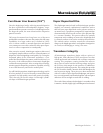
Since the diaphragm of an electrostatic speaker is uniformly
driven over its entire area, it can be extremely light and
flexible. This allows it to be very responsive to transients,
thus perfectly tracing the music signal. As a result, great
delicacy, nuance and clarity are possible. When you look
at the problems of traditional electromagnetic drivers, you
can easily see why this is so beneficial. The cones and
domes which are used in traditional electromagnetic
drivers cannot be driven uniformly because of their design.
Cones are driven only at the apex. Domes are driven at
their perimeter. As a result, the rest of the cone or dome
is just “along for the ride”. The very concept of these
drivers requires that the cone or dome be perfectly rigid,
damped and massless. Unfortunately, these conditions are
not available in our world today.
To make these cones and domes move, all electromagnetic
drivers must use voice coils wound on formers, spider
assemblies and surrounds to keep the cone or dome in
position (See Figure 12). These pieces, when combined
with the high mass of the cone or dome materials used,
make it an extremely complex unit with many weaknesses
and potential for failure. These faults contribute to the
high distortion products found in these drivers and is a
tremendous disadvantage when you are trying to change
motion as quickly and as accurately as a loudspeaker
must (40,000 times per second!).
Electrostatic Advantages 13
Figure 12. Cut-away view of a typical moving coil driver.
Notice the complexity due to the high number of parts.


















